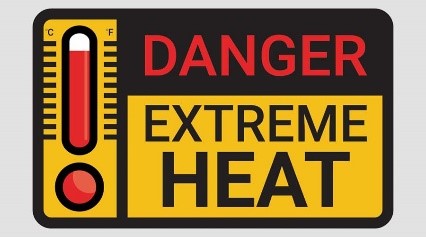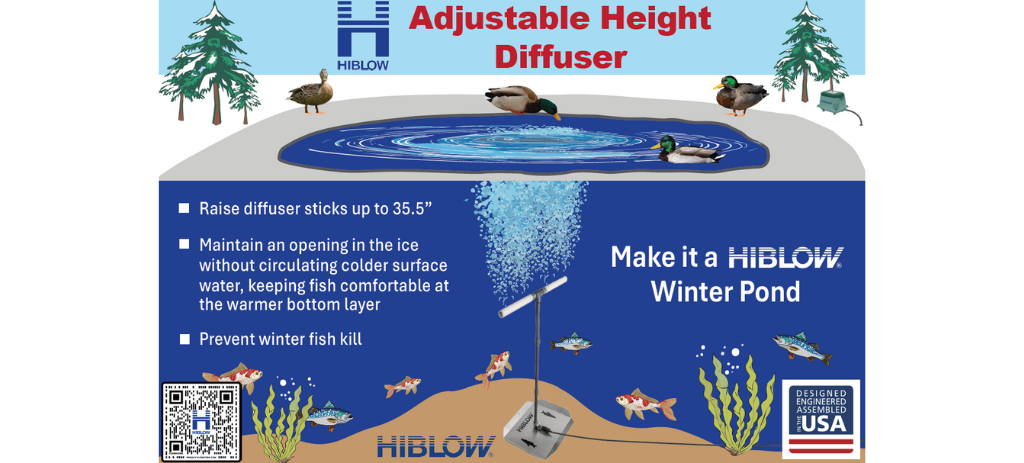If you own a pond aerator, you might be wondering whether you need a cover for it. If your system uses a rocking piston, rotary vane, or regenerative blower, then investing in a pond aerator cover is a smart move. These technologies aren’t designed to withstand direct exposure to the elements. Rain, snow, dust, and UV rays can all damage components and potentially shorten the lifespan of the unit.
While each type of aerator varies in durability and heat output, most benefit from a weather-resistant, well-ventilated enclosure that offers protection without restricting airflow.
Do Linear Diaphragm Air Pumps Need a Pond Aerator Cover?
HIBLOW aerators and other linear diaphragm brands (though not all) are UL-rated for outdoor use, meaning they can operate without a pond aerator cover and still withstand the elements. Most HIBLOW pond aerators feature aluminum housing that essentially acts as the enclosure.
However, many in the pond industry believe that a cover is necessary and often use fake rocks or other decorative enclosures that may restrict airflow. While some enclosures can be beneficial, others can actually reduce the lifespan of the aerator.

Heat Is the Enemy
HIBLOW’s diaphragms are made from EPDM rubber, which wears and ruptures more quickly in hot environments. Other rubber components, such as base and filter gaskets, also degrade faster under heat stress. While you can’t control the outside temperature, you can position your pump to maximize its longevity. Keeping the aerator out of direct sunlight and ensuring proper air circulation is the best way to extend its life.
Heat Test – Enclosures vs. Stand-Alone Setups
HIBLOW USA conducted a heat test, measuring temperatures for three different types of enclosures and for a HIBLOW air pump placed in both shade and direct sunlight.
Testing Conditions:
Temperatures were measured at the top and bottom of each setup every 30 minutes between 10:30 AM and 2:30 PM.
Starting temperature at 10:30 AM: 83°F (Real Feel: 94°F); ending temperature at 2:30 PM: 86°F (Real Feel: 97°F).
Location: Saline, MI.

Results at 2:30 PM (warmest time of the day):
| Type | Temperature at the top | Temperature at the Bottom | Average Temperature | |
| A | No enclosure in the shade | 116.3 °F | 129.9 °F | 123.1 °F |
| B | Enclosure with 2 open ends | 122.9 °F | 127.7 °F | 125.3 °F |
| C | No enclosure directly in the sun | 123.1 °F | 129.2 °F | 126.2 °F |
| D | Fake rock without vents | 132.2 °F | 136.0 °F | 134.1 °F |
| E | Riser top without vents | 136.8 °F | 149.5 °F | 143.2 °F |
Temperature Rankings (Coolest to Hottest):
#1 – A: No enclosure, in the shade.
No surprise here—this setup offers the best of both worlds: protection from the sun and unrestricted airflow. People often place pumps on the north side of the house, under trees, in sheds, garages, or crawlspaces.
#2 – B: Enclosure with two open ends.
Offers good airflow while keeping the aerator shaded. This is a quality setup.
#3 – C: No enclosure, in direct sun.
This setup’s higher temperature shows that airflow may be more important than shade alone when keeping the pump cool.
#4 – D: Fake rock without vents.
Although visually appealing, this setup restricts ventilation and significantly raises internal temperatures. Your diaphragms may rupture much faster.
#5 – E: Riser top without vents.
More common in the septic industry, this setup is risky for ponds. Aside from potential water intrusion and toxic gas exposure, the pump essentially “bakes” inside. As shown, this setup was 20°F hotter than a shaded pump in Michigan—worse in hotter states like Texas or Louisiana.
The Bottom Line:
To extend the life of your pond aerator and save money, aim to maximize airflow and keep the pump shaded. If you choose to use a pond aerator cover, ensure it’s ventilated. Drill holes in decorative covers or prop them up to allow air circulation from below.
If you have any questions about pond aerator covers or your HIBLOW air pump, please give us a call—we’d be happy to offer suggestions to improve your setup.
More Pond Aeration Content
- What Size Air Pump Should I Buy?
- DIY Pond Aeration
- How to Calculate Backpressure
- What Type of Diffuser Should I Buy for My Pond?
- How Water Depth, Pipe Size and Diffuser Type Affect Longevity
- DIY Solar Pond
- Pond Aerator System Maintenance
- New Adjustable Height Diffuser
- For all HIBLOW pond aeration content click here
Author: Mike Miner








